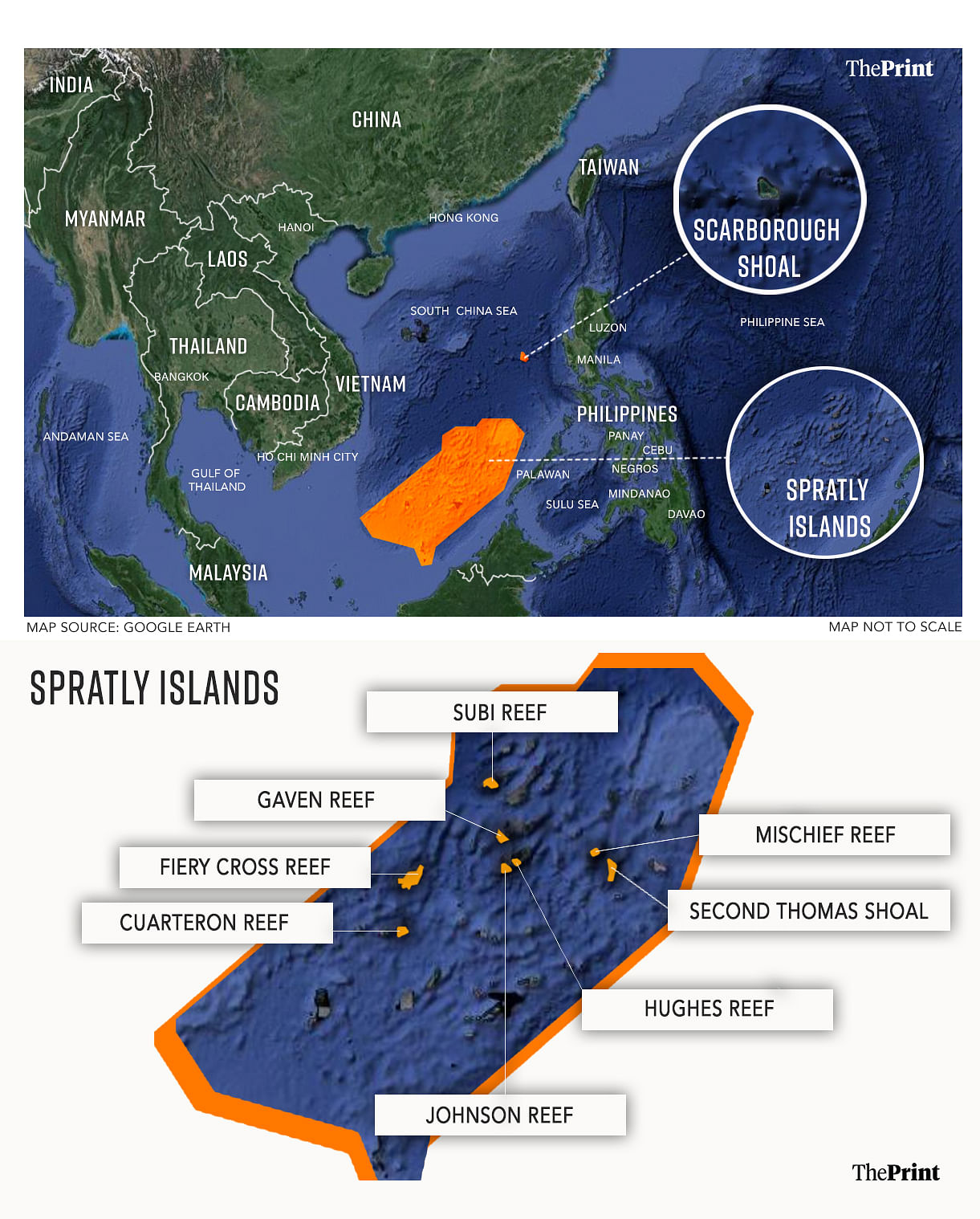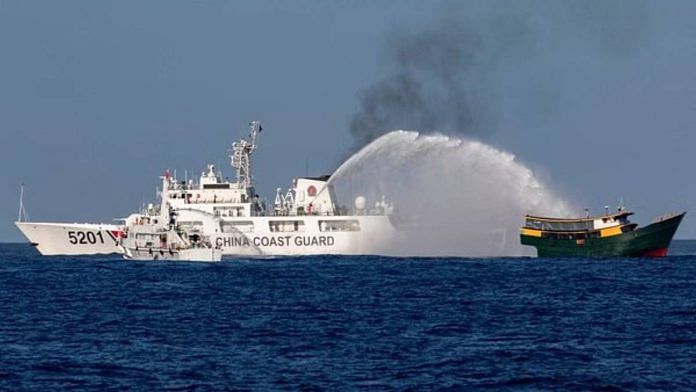New Delhi: External Affairs Minister S. Jaishankar said Tuesday that India backs the Philippines in upholding its national sovereignty amid rising tensions between Manila and Beijing over disputed waters in the South China Sea.
Tensions between the Philippines and China have escalated over the last two years, mainly over two disputed territories: Scarborough Shoal and the Spratly Islands. The former is about 120 nautical miles (222 km) west of the Philippine island of Luzon and is considered a part of the Philippines’ Exclusive Economic Zone (EEZ).
The Spratly Islands are a group of over 100 islands and reefs, and while the Philippines claims some parts, China lays claim to the entire archipelago.
China calls the Scarborough Shoal ‘Huangyan Dao’ while the Filipino name for it is ‘Panatag Shoal’ or ‘Bajo de Masinloc’.
In the latest flare-up, which took place on 23 March, the Philippines accused the Chinese Coast Guard of injuring its personnel in a water cannon attack near the Second Thomas Shoal. Manila summoned Beijing’s envoy over the incident, which was the second attack at the disputed shoal within a month.
The Second Thomas Shoal is one of many disputed territories in the Spratly Islands. Many of these are home to rich fishing areas and potential gas and oil deposits.
On Wednesday, responding to Jaishankar’s remark, the Chinese foreign ministry said that “third parties” have no right to interfere in maritime disputes. Meanwhile, the US condemned controversial Chinese activities in the South China Sea, while South Korea expressed “concern”.

Also Read: ‘Third parties have no right to interfere,’ says China on India backing Philippines
Warming of ties under Bongbong Marcos
The last couple of years have seen an escalation of tensions in the South China Sea, marked by controversial efforts by Chinese Coast Guard vessels and fishing boats in disputed waters and collisions between Chinese and Philippine vessels.
Analyst Dean Cheng says these Chinese efforts reveal a sophisticated “exploitation of gray zone” and “hybrid warfare techniques”.
Former Philippines President Rodrigo Duterte was viewed as anti-US, especially after announcing his “separation” from Washington during a conference in Beijing in October 2016, implying he was aligning himself with China and Russia. Though he attempted to scale back his remarks, it cast a shadow over the US-Philippines bilateral ties.
That said, in April 2019, Duterte did issue a stern warning to China to “lay off Pag-asa” —referring to the site of Manila’s largest outpost in the South China Sea. At the time, hundreds of Chinese Coast Guard and fishing vessels had surrounded the island.
Ties with the US were re-energised after the current Philippines President Ferdinand “Bongbong” Marcos Jr. took office in June 2022. Under him, the two countries revised guidelines in a 1951 Mutual Defense Treaty which stated that mutual defence commitments would be invoked in an armed attack on either country “anywhere in the South China Sea”.
Last April, the Philippines gave the US access to four additional military bases which allows the American military to store defence equipment and supplies there. The four new sites include: Naval Base Camilo Osias in Santa Ana, Cagayan; Camp Melchor Dela Cruz in Gamu, Isabela; Balabac Island in Palawan; and Lal-lo Airport in Cagayan.
This is in addition to the five existing Philippines sites that the US has access to, bringing the total number to nine.
Last April, both countries also held their largest military exercise in history with nearly 18,000 soldiers from both nations taking part in drills.
The Philippines has bought BrahMos supersonic cruise missiles, a joint venture by India and Russia, and is contemplating acquiring more to enhance protection of its coastlines in the Indo Pacific region.
What happened in 2016 case of Philippines vs China?
In 2013, the Philippines filed a case against China at a Hague-based arbitral tribunal at the Permanent Court of Arbitration. Manila accused Beijing of “excessive” maritime claims at Scarborough Shoal and in the Spratly Islands.
With regard to the Second Thomas Shoal — the site of the recent water cannon incident — Philippines had then accused China of 1) interfering with the Philippines’ rights of navigation in the waters at and adjacent to the shoal and 2) preventing the rotation and resupply of Philippine personnel stationed at the shoal.
It also accused Beijing of conducting dredging, artificial island-building and construction activities at disputed territories in the Spratly Islands, such as Mischief Reef, Cuarteron Reef, Fiery Cross Reef, Gaven Reef, Johnson Reef, Hughes Reef and Subi Reef.
China did not participate in the proceedings despite being a signatory to the treaty establishing the tribunal. It argued that both countries had agreed through bilateral pacts to settle their disputes through negotiations.
In 2016, however, the tribunal decided in the Philippines’ favour. It found no legal basis for China to claim historic rights to resources within areas it laid claim to in the South China Sea as falling within the “nine-dash line”.
The nine-dash line is a set of line segments detailing China’s claims over various areas of the South China Sea, many of which are disputed territories.
The tribunal appointed an expert hydrographer to assist it in evaluating the various disputed claims. It found that Mischief Reef, Second Thomas Shoal and Reed Bank are part of the Philippines’ EEZ and continental shelf of the Philippines, and “are not overlapped by any possible entitlement of China”.
The court also found that China had interfered with Philippine petroleum exploration at Reed Bank.
Reed Bank is an underwater reef formation lying northeast of the Spratly Islands and off the Philippine island of Palawan. In 2019, it was the site of a major clash when a Philippine fishing boat sank after it was rammed by a Chinese vessel.
In its judgment, the tribunal noted that although Chinese navigators and fishermen had historically made use of the islands, there was “no evidence that China had historically exercised exclusive control over the waters or their resources”.
Philippines supporters, such as India and the US, have repeatedly referred to the 2016 ruling as evidence of China’s “unlawful” maritime claims against the country.
Last August, China released the 2023 edition of its “standard map” which included claims to Spratly Islands and Scarborough Shoal, despite the 2016 ruling. The map included the nine-dash line.
The 2023 edition of China's standard map was officially released on Monday and launched on the website of the standard map service hosted by the Ministry of Natural Resources. This map is compiled based on the drawing method of national boundaries of China and various countries… pic.twitter.com/bmtriz2Yqe
— Global Times (@globaltimesnews) August 28, 2023
India, Vietnam, the Philippines, Malaysia, and Brunei have contested the map as it included parts of what these countries consider part of their own territory. This was the same map India had contested as it shows Arunachal Pradesh as part of what China considers “South Tibet” as well as Aksai Chin.
(Edited by Nida Fatima Siddiqui)
Also Read: A divided ASEAN only strengthens China. It’s a risk to Indo-Pacific security



